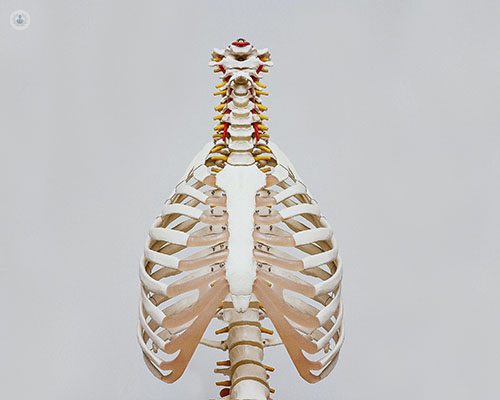Rib fractures: a comprehensive guide for patients
Escrito por:Highly skilled consultant thoracic surgeon Mr Marco Scarci explains everything you need to know about recovering from fractured or broken ribs.
How long does a fractured rib take to heal?
As with any broken bone, a fractured rib will take the same some time to heal. It may take the same time to heal as some of the other fractures you might have suffered previously. Usually, most ribs fractures heal on their own within 3 months.
The most important difference to highlight when comparing fractured ribs to other bone injuries is that the latter are usually treated in such way to immobilise the two edges for a period of time to allow healing.
Unfortunately, this is not possible with ribs fractures as we cannot put the chest in a cast and the fractures will continue moving constantly due to breathing and normal every day activities.

How to treat fluid in lungs after broken ribs?
After ribs fractures, especially after a significant trauma or when patients are taking blood thinners, it is possible that the edges of the fracture bleed into the chest cavity.
Blood tends to coagulate pretty quickly in the edges, causing a haemothorax. A haemothorax is a collection of old blood into the chest cavity. The result of this is that the accumulated fluid compresses the lung and breathing may become impaired.
In this situation the fluid must be removed. To achieve this, a chest tube can be inserted or, more commonly, a keyhole procedure is performed to drain properly the collection.
Why is my broken rib pain getting worse?
Most ribs fractures tend to heal within three months, but occasionally this is not the case and pain either tends to increase or remain constant with no signs of abating. This is due to a condition called mal-union or bad healing of the fracture.
As previously mentioned, the ribs keep moving all the time during the healing process. Due to this, sometime there is a lack of new bone formation and the rib edges become surrounded by fibrous tissue. This is not as strong as bone and it is like a pliable piece of wood, this movement causes pain.
In the past, we would remove the affected part and leave a gap between the edges of the rib. Nowadays we use a titanium metallic plate to fix the rib in the correct position and eliminate the pain.
What are the long- term effects of broken ribs
Most rib fractures heal on their own leaving no long- term effect. In some cases, due to a case of severe trauma and multiple fractures, if they don’t heal properly, you can get a deformity of the chest and restriction in breathing.
Some patients may experience chronic pain, especially in case of malunion. Others may experience recurrent fluid accumulation into the chest cavity, but this is very rare.
What is broken ribs pneumonia symptoms?
Broken ribs are very painful and as a result, patients tend to reduce the depth of their breaths in order to reduce pain and avoid all activities that might trigger further pain. If the lungs fail to expand for a prolonged period of time, phlegm tends to accumulate inside the lung and airways causing pneumonia. This is even more commonplace in frail patients.
Patients often refrain from coughing, which further exacerbates the problem. They can develop a high temperature, feel sweaty with rigor and struggle to breath. If suffering from such symptoms, you should always seek immediate medical attention.
How can I quickly heal broken ribs?
As previously, mentioned ribs tend to heal on their own, but every now and then patients are referred for surgery to fix them using thin metallic plates that are screwed to the ribs. This technique is particularly useful in elderly and frail patients or patients that have sustained a significant trauma causing what we call a flail chest. This is a condition when ribs get fractured in more than one place causing paradoxical breathing. In this scenario the rib cage moves in the opposite way to where it should be. It sinks in during inhalation and blows out during exhalation.
The surgical technique is very safe and reliable. The improvement in pain and breathing is usually pretty quick and patients tend to improve quickly after surgery. By using a CT scan to identify accurately the position of the fracture(s), we can reduce significantly the size of the incision.
How long will I be off work with broken ribs?
The amount of time off work due to broken ribs mainly depends on individual circumstances. Generally speaking, patients that do manual work must stay off work for a lot longer than those with clerical occupations. People with clerical occupations tend to go back to work after 2-3 weeks if the pain has subsided completely or if it is manageable with an over-the-counter pain killer.
If you would like to book a consultation with Mr Scarci, you can do so through his Top Doctors profile today.


